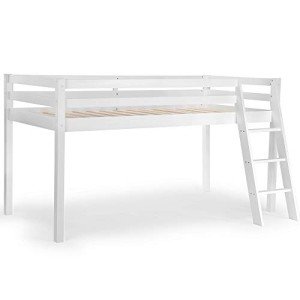The Ultimate Guide to Bunk Beds for Kids: Safety, Styles, and Solutions
Bunk beds have actually long been a popular option amongst parents looking for to optimize space in their kids's bedrooms. With benefits that exceed their compact design, bunk beds provide a fun and functional sleeping arrangement while encouraging brother or sister bonding and cultivating imagination. In this detailed guide, we explore various aspects of bunk beds for kids, including safety factors to consider, different styles available, and recommendations for picking the best one for your household.
Why Choose Bunk Beds?
Bunk beds are developed to stack one bed on top of another, utilizing vertical space to develop more room for play and storage. They are especially beneficial for families with multiple kids or minimal bed room space. Additionally, Bunk Beds Store supply an adventurous sleeping environment that children often delight in.
Secret Advantages of Bunk Beds:
- Space-saving style: Ideal for little spaces or shared spaces.
- Cost-effective: Often more economical than buying two separate beds.
- Encourages social interaction: Promotes bonding among siblings or buddies.
- Versatile choices: Available in various designs and configurations to suit any space design.
Safety First: Essential Considerations
When choosing a bunk bed for kids, security must be the top concern. The following features are essential for ensuring a protected sleeping environment:
Important Safety Features:
- Sturdy Construction: Ensure that the bed frame is made from durable materials such as solid wood or metal.
- Guardrails: Bunk beds should have guardrails on both sides of the upper bunk to avoid falls.
- Ladder Safety: A tough, integrated ladder or stairs with anti-slip rungs is important for safe access to the leading bunk.
- Weight Limit: Check the producer's weight limit capacity for both the top and bottom bunk.
- Bed mattress Size: Use the proper bed mattress size as defined by the bed maker to guarantee a tight fit within the bed frame.
Security Tips for Parents:
- Monitor Sleep Habits: Teach children the importance of not playing on or leaping off the bunk beds.
- Age Appropriateness: Generally, the upper bunk appropriates for children aged 6 and older.
- Regular Inspections: Periodically examine for any loose bolts, screws, or structural damage.
Designs of Bunk Beds
Bunk beds come in a variety of designs, enabling moms and dads to choose one that matches their child's space design while conference specific needs. Below are some popular styles:
Popular Bunk Bed Styles:
- Traditional Bunk Beds: Simple and timeless designs made from wood or metal without any additional features.
- Loft Beds: Features a raised top bunk with space underneath for a desk, play area, or extra storage.
- L-Shaped Bunk Beds: Arranged in an L-shape, often ideal for corner areas and can have additional storage alternatives.
- Twin over Full Bunk Beds: A twin bed on leading and a larger full-sized bed on the bottom, accommodating children or teens of various ages.
- Triple Bunk Beds: Designed to fit three beds in a single footprint, ideal for larger families or slumber parties.
A Comparison of Bunk Bed Styles
| Bunk Bed Style | Description | Best For |
|---|---|---|
| Standard | Timeless design with 2 stacked beds | Requirement bedroom setups |
| Loft Bed | Raised bed with usable space underneath | Research or play locations |
| L-Shaped | Bunk beds organized in an L-shape | Corner spaces |
| Twin over Full | Twin bed on top, full bed below | Different age siblings |
| Triple Bunk | Three stacked beds | Large families or pajama parties |
Selecting the Right Bunk Bed
When looking for the perfect bunk bed, consider the following factors to guarantee you make a notified choice:
Key Factors to Consider:
- Room Size: Measure the room dimensions to determine the appropriate size and height of the bunk bed.
- Child's Age: Consider the age of your child(ren) when selecting a design and safety functions.
- Performance: Think about how much storage or play space you need and whether the bunk bed ought to serve additional purposes.
- Spending plan: Set a spending plan that consists of not only the bunk bed however also the needed mattress and devices like bedding or safety gates.
Frequently Asked Questions About Bunk Beds for Kids
1. What age is proper for a kid to sleep in the top bunk?
Normally, children aged 6 and older must have the ability to safely sleep in the leading bunk, though you should always consider your child's maturity level.
2. Are bunk beds safe for toddlers?
It is not recommended for young children or extremely kids to oversleep the leading bunk due to the danger of falling.
3. How do I keep the bunk bed?
Check the bed frequently for any signs of wear and tear, tightening screws, and cleaning the mattresses to guarantee prolonged security and toughness.
4. Can I convert a bunk bed into two different beds?
Numerous bunk beds are created to be convertible, permitting you to separate the beds when needed. Examine the maker's requirements before acquiring.
5. How can I make the most of space in a bunk bed room?
Utilize under-bed drawers, shelves, or lofted designs to develop additional storage options in a space with a bunk bed.
Bunk beds use a delightful mix of enjoyable, functionality, and space-saving utility, making them a perfect option for young households. By considering security functions, numerous designs, and practical aspects such as room size and age suitability, parents can select the best bunk bed for their child's requirements. With the right option, bunk beds can transform a bed room into a magical space that encourages play, creativity, and bonding amongst siblings. Always remember to focus on safety and upkeep to maximize this special sleeping plan.

